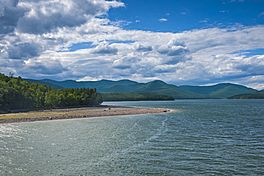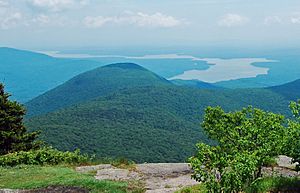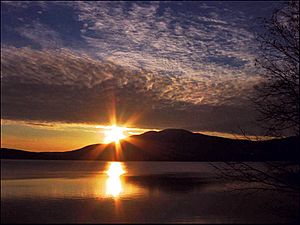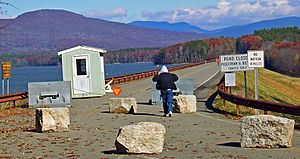Ashokan Reservoir facts for kids
Quick facts for kids Ashokan Reservoir |
|
|---|---|

Ashokan Reservoir in July 2016
|
|
| Location | Ulster County, New York, United States |
| Coordinates | 41°57′N 74°13′W / 41.950°N 74.217°W |
| Type | Reservoir |
| Primary inflows | Esopus Creek |
| Primary outflows | Esopus Creek |
| Basin countries | United States |
| Max. length | 12 mi (19 km) |
| Max. width | 1 mi (2 km) |
| Surface area | 8,300 acres (3,400 ha) |
| Average depth | 46 ft (14 m) |
| Max. depth | 190 ft (58 m) |
| Water volume | 122.9 billion gallons (465 million m3) |
| Shore length1 | 40 mi (60 km) |
| Surface elevation | 585 ft (178 m) |
| 1 Shore length is not a well-defined measure. | |
The Ashokan Reservoir (its name means "place of fish" in Iroquois) is a large reservoir in Ulster County, New York. It sits at the eastern end of the Catskill Park. This reservoir is one of several in the region that were built to provide water to New York City. It is the city's deepest reservoir. It reaches about 190 feet deep near the dam where Bishop Falls used to be.
Contents
Building the Ashokan Reservoir: A Look Back
In the early 1900s, New York City needed more clean water. City leaders looked to the Catskill Mountains for a solution. They found that much of the land in the Catskills was state-owned. This land, called Forest Preserve, could not be sold easily. This made it a good place for a new water source.
A new law in 1905 allowed New York City to buy land. This law also let the city build dams, reservoirs, and aqueducts in the Catskills. This was a big step towards creating the Ashokan Reservoir.
Challenges and Changes for Local Communities
Building the reservoir meant flooding a large area. Many local people did not want to leave their homes. They fought against the city's plans to buy their land. It took many years for all these land disagreements to be settled.
The Ashokan Reservoir was built between 1907 and 1915. Workers created it by blocking the Esopus Creek. This project submerged thousands of acres of farmland. Twelve communities were located in the valley that became the reservoir. These communities had farms, shops, churches, and homes.
About 2,000 people had to move. Their homes, roads, and even cemeteries were either moved or taken down. Some communities, like West Shokan and Olivebridge, were rebuilt nearby. A local railroad line, the Ulster and Delaware Railroad, was also moved.
Who Built the Reservoir?
Many people worked on building the dam. These included local workers, African-Americans, and Italian immigrants. They also cleared trees and buildings from the area. Sometimes, there were disagreements in the work camps. So, a police force was created to keep things peaceful. This force later became the New York City Department of Environmental Protection (NYCDEP) Police.
The dam was built using Rosendale cement. This cement was known as the strongest in the world at that time. When the dam was finished, loud steam whistles blew for an hour. This was a signal for everyone in the valley to leave right away.
Today, some of the relocated communities still exist along the reservoir's edges. These include Olivebridge and Shokan. Other communities, like Brown's Station, are remembered with historical markers.
Ashokan Reservoir Facts and Figures

The Ashokan Reservoir started providing water in 1915. This makes it the oldest New York City reservoir in the Catskill Mountains. It is located in Ulster County, New York. It is about 13 miles west of Kingston, New York. It is also about 93 miles north of New York City.
This reservoir is one of New York City's largest. It holds a lot of water and covers a big area. When it is full, it can hold 122.9 billion gallons of water. It is also the city's deepest reservoir, reaching over 180 feet deep.
How Water Flows Through the Reservoir
Routes 28 and 28A go around the reservoir. Many of the moved villages are along these roads. The reservoir is split into two parts, called basins. A road with a causeway runs over the middle of it. Water does not flow freely between the two basins. The eastern basin is slightly lower than the western basin.
Water for the Ashokan Reservoir comes from different places. Some water comes from the Schoharie Reservoir. This water travels through the 16-mile Shandaken Tunnel. The tunnel empties into the Esopus Creek. The Ashokan Reservoir also gets water from the Esopus Creek and its smaller streams.
From the Ashokan Reservoir, water flows into the 92-mile Catskill Aqueduct. This aqueduct carries the water to the Kensico Reservoir. There, it mixes with water from the Delaware Aqueduct. Finally, the water flows a few more miles to the Hillview Reservoir in Yonkers, New York. This is the main collection point for the city's water.
Activities at the Ashokan Reservoir

To keep the water clean and the old dams safe, only certain activities are allowed around the reservoir. These activities include fishing and some types of logging. You need a special permit to do these things. For example, if you want to go boating or fishing, you need a public access permit issued after 2002.
Some activities are not allowed to keep the water as clean as possible. Swimming and diving are strictly forbidden. It is also against the rules to bring boats with gasoline engines. This is to prevent gasoline from leaking and polluting the water.
When the dam was built, pine and spruce trees were planted around the banks. This was done to stop soil from washing away. Engineers at the time also believed that these trees helped keep the water cleaner than other types of trees.
After a security concern in 2001, the city and state decided to close the spillway road permanently to cars. This means people on the south side of the reservoir have to travel much farther to reach places on the north side. The city helps the local school district with the extra fuel costs for their buses. However, the Reservoir Road causeway is still open for travel.
See Also
- New York City water supply system
Images for kids
-
The reservoir seen from the summit of Wittenberg Mountain. Samuel's Point is in the foreground.
-
Sunset over Ashokan High Point, a nearby mountain which provides a scenic backdrop to the reservoir











